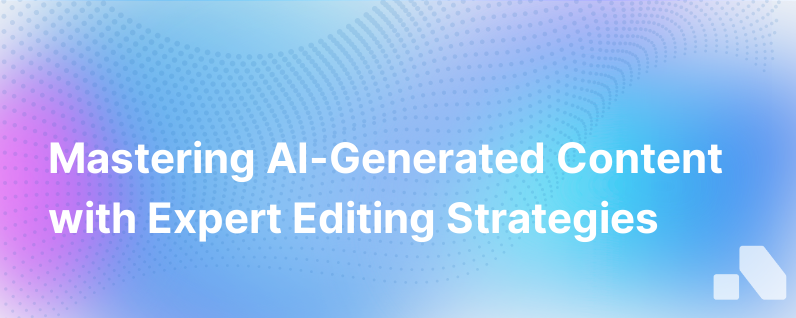Pro Tips On How To Edit Content Created By Generative Ai
Published on September 7, 2023 by Sawyer Middeleer
In the rapidly evolving landscape of digital content creation, generative AI has emerged as a game-changing technology. With the ability to churn out content at an unprecedented scale and speed, it's not only facilitating efficiency but also transforming the role of content creators. However, AI-generated content often lacks the nuanced understanding and creativity that human editors bring to the table. Therefore, editing content created by AI is crucial to ensuring it meets the high standards of quality and engagement that audiences expect.
Here’s an extensive guide on how to edit content generated by artificial intelligence effectively, ensuring it retains the human touch that resonates with readers.
Understanding the Basics of Generative AI in Content
Generative AI, such as GPT-3 and similar models, uses complex algorithms to produce text-based content. These tools are trained on extensive internet text data, allowing them to generate articles, reports, social media posts, and more.
The first step in editing AI content is to understand its capabilities and limitations. Generative AI can provide quick drafts that cover basic information on a topic, but it often struggles with context, tone consistency, originality, and sometimes factual accuracy. Recognizing this allows editors to approach the AI-created content with a critical eye.
Pro Tips for Editing AI-Generated Content
Here are the crucial strategies for refining AI-created content:
1. Reassert the Human Angle
AI tends to present information in a mechanistic way. It’s crucial to go through the content and add anecdotes, personal insights, emotional angles, or context that makes the content more relatable and engaging for human readers. Human experiences and stories create connections with your audience that AI simply can't replicate.
2. Verify Factual Accuracy
One of the most significant issues with generative AI is its occasional lapse in accuracy. As a content editor, verify all facts, statistics, and references the AI has produced. Use reputable sources to validate each data point and claim to maintain credibility and avoid the dissemination of misinformation.
3. Refine the Voice and Tone
AI-generated content might not align with your brand’s voice or the intended tone for the piece. Adjust the language, add idiomatic expressions, and tweak sentence structures to ensure the content aligns with your brand and resonates with your intended audience.
4. Enhance Readability and Flow
For content to be engaging, it needs to flow smoothly. Generative AI can sometimes produce jarring transitions or convoluted sentences. Break up lengthy paragraphs, add subheadings, bullet points, and transition words to guide the reader seamlessly through the piece.
5. Check for Plagiarism
Although generative AI is designed to create unique content, its training on existing internet data means there’s a risk of producing sentences or paragraphs that closely mimic published content. Use plagiarism checkers to ensure originality and avoid potential copyright infringement.
6. Encourage Creativity
AI lacks innate creativity. To captivate readers, enhance creative elements within the content. Infuse your brand's unique style, include visual metaphors, and ensure the content triggers the imagination of your readership.
7. Optimize for SEO
While AI can follow SEO best practices, human intervention is needed to strategically tailor content. Verify keyword placement, assess meta descriptions, and ensure that headings are optimized to boost search engine ranking and visibility.
8. Reinforce the Purpose
What action do you want your readers to take after engaging with your content? Whether it’s to educate, sell a product, or provoke thought, make sure that your call-to-action is clear and compelling. AI may not always nail this, requiring you to sharpen the message.
9. Incorporate Feedback Mechanisms
Generative AI cannot learn from its mistakes unless guided by human feedback. Incorporate user feedback into AI prompts for future iterations. This creates a feedback loop that continuously improves the quality of AI-generated content.
10. Legal and Ethical Considerations
Thoughtfully assess any generative AI content for legal and ethical compliance. Be transparent about AI usage, ensure data protection standards are met, and edit any content that risks perpetuating biases or stereotypes.
11. Continuous Learning and Adaptation
Stay abreast with the evolving capabilities of generative AI technology. Advance your understanding of how AI works, what’s new in AI content generation, and continuously adapt your editing process.
Final Thoughts
Editing AI-generated content requires a combination of technical proficiency, creative thinking, and an editorial acumen deeply rooted in understanding the audience. By applying these pro tips, editors can greatly enhance the quality of AI-produced content, elevating it to meet - and possibly exceed - the quality of human-generated content.
For those utilizing AI platforms like Aomni for B2B sales automation, the same principles apply. Refine the AI-generated insights, tweak the automated reports, and personalize the sales content to ensure that it meets the specific needs of your clients and represents your brand accurately.
In conclusion, while generative AI offers incredible benefits in terms of efficiency and scalability, it is the human touch in the editing process that ensures the content achieves its intended impact. By adopting a meticulous approach to editing, content marketers and SEO experts can harness the full power of AI while retaining the authenticity and creativity needed to truly engage an audience.